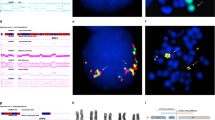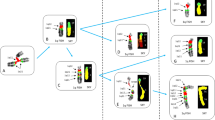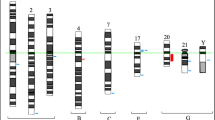Abstract
The metallothioneins (MTs) are a family of proteins of low relative molecular mass which bind heavy-metal ions1. MTs exist in several molecular forms (MT-I, MT-II) and are encoded by a multi-gene family containing at least 14 closely related genes and pseudogenes1,2. These proteins function in the regulation of trace-metal metabolism, the storage of these ions in the liver, and as a protective mechanism against heavy-metal toxicity3. Somatic cell hybridization has shown that most MT genes, including the functional MT genes (MT1A, MT1B, MT2A), lie on human chromosome 16 (refs 4, 5). Using in situ hybridization6,7, we have now localized the MT genes to band q22 of chromosome 16. This chromosomal band is also a breakpoint in two specific rearrangements, the inv(16)(p13q22) (ref. 8) and t(16; 16)(pl3;q22) rearrangements, found in a subgroup of patients with acute myelomonocytic leukaemia (AMML). Hybridization of a MT probe to malignant cells from two patients with an inv(16) showed labelled sites on both arms of the inverted chromosome, indicating that the breakpoint at 16q22 splits the MT gene cluster. Similar results were obtained when this probe was hybridized to metaphase cells from two patients with a t(16; 16). These results suggest that the MT genes or their regulatory regions9 may function as an ‘activating’ sequence for an as yet unidentified cellular gene located at 16pl3.
This is a preview of subscription content, access via your institution
Access options
Subscribe to this journal
Receive 51 print issues and online access
$199.00 per year
only $3.90 per issue
Buy this article
- Purchase on Springer Link
- Instant access to full article PDF
Prices may be subject to local taxes which are calculated during checkout
Similar content being viewed by others
References
Kagi, J. H. R. & Nordberg M. (eds) Experientia Suppl. 34 (1979).
Karin, M. & Richards, R. I. Nature 299, 797–802 (1982).
Durnam, D. M. & Palmiter, R. D. J. biol. Chem. 256, 2268–2272 (1981).
Schmidt, C. J., Hamer, D. H. & McBride, O. W. Science 224, 1104–1106 (1984).
Karin, M. et al. Proc. natn. Acad. Sci. U.S.A. 81, 5494–5498 (1984).
Harper, M. E. & Saunders, G. F. Chromosoma 83, 431–439 (1981).
Le Beau, M. M., Westbrook, C. A., Diaz, M. O. & Rowley, J. D. Nature 312, 70–71 (1984).
Le Beau, M. M. et al. New Engl. J. Med. 309, 630–636 (1983).
Karin, M. et al. Nature 308, 513–519 (1984).
Karin, M. & Richards, R. I. Nucleic Acids Res. 10, 3165–3173 (1982).
Arthur, D. C. & Bloomfield, C. D. Blood 61, 994–998 (1983).
Testa, J. R., Hogge, D. E., Misawa, S. & Zand-Parsa, N. New Engl. J. Med. 310, 468–469 (1984).
de la Chapelle, A. & Lahtinen, R. New Engl. J. Med. 308, 1394 (1983).
Gustafson, P. E. et al. Scand. J. Haemat. 4, 371–379 (1967).
Barnes, D. & Sato, G. Cell 22, 649–655 (1980).
Richards, R. I., Heguy, A. & Karin, M. Cell 37, 263–272 (1984).
Le Beau, M. M. & Rowley, J. D. Nature 308, 607–608 (1984).
Yunis, J. Science 221, 227–236 (1983).
Arthur, D. C. & Bloomfield, C. D. Blood 62, Suppl. 1, 165a (1983).
Author information
Authors and Affiliations
Rights and permissions
About this article
Cite this article
Le Beau, M., Diaz, M., Karin, M. et al. Metallothionein gene cluster is split by chromosome 16 rearrangements in myelomonocytic leukaemia. Nature 313, 709–711 (1985). https://doi.org/10.1038/313709a0
Received:
Accepted:
Issue Date:
DOI: https://doi.org/10.1038/313709a0
This article is cited by
-
Association of Estrogen Receptor-α Gene & Metallothionein-1 Gene Polymorphisms in Type 2 Diabetic Women of Andhra Pradesh
Indian Journal of Clinical Biochemistry (2012)
-
Metallothionein expression correlates with metastatic and proliferative potential in squamous cell carcinoma of the oesophagus
British Journal of Cancer (1999)
-
Advances in cytogenetic analysis of solid tumours
Chromosome Research (1996)
-
Comparative map for mice and humans
Mammalian Genome (1992)
-
Comparative map for mice and humans
Mammalian Genome (1991)
Comments
By submitting a comment you agree to abide by our Terms and Community Guidelines. If you find something abusive or that does not comply with our terms or guidelines please flag it as inappropriate.



